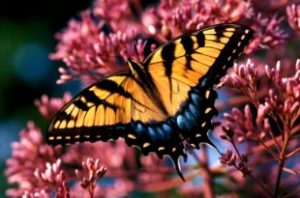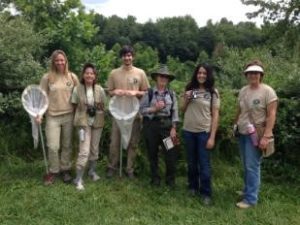Quick: Think of a butterfly!
The snow we are facing this week has us daydreaming about the return of warm weather. Our thoughts are fluttering with images of blooming flowers and the return of pollinators like butterflies, hummingbirds, and bees. We are excited, too, for our CVNP volunteers to spread their wings and explore the wonders of butterflies.
Every week during the summer, a team of citizen scientists counts dozens of butterflies in CVNP. Each wing stripe, color morph, and flight pattern is familiar to them as they hunt for these tiny creatures in woodlands and meadows.
Despite their different levels training, these volunteers’ findings are indispensable to scientists and naturalists around the country.
The Rise of Citizen Science
Citizen science—the collection and analysis of data by members of the public—is gaining traction nationwide. Instead of a few scientists scattered across the country collecting tiny amounts of data, we can harness the power of thousands of eager volunteers.
Through the Cornell Lab of Ornithology, over 200,000 volunteers submit data to track birds, including several volunteer groups here in CVNP. The Galaxy Zoo online program has drawn half a million people to help catalogue galaxy shapes. And there are more than a thousand sites across the U.S. tracking monarch butterfly populations. Citizen Science groups are using INaturalist and are now contributing to the Ohio Bee Atlas project.
Smartphone apps, online forums, and instant communication around the globe create a vast network for scientists and researchers to draw upon. A simple count of birds or butterflies from CVNP can turn into a data point for climate change research almost instantaneously.
Citizen science might be easier today with current technology, but it’s not necessarily a new concept. Carl Linnaeus, the father of biology’s modern naming system, relied heavily on submissions from amateur researchers for his work. Charles Darwin even worked with a network of amateurs to gather observations about the natural world for The Origin of Species.
Today, we continue the tradition of citizen science in Cuyahoga Valley National Park.
Chasing Butterflies
The park’s butterfly monitoring program is one of the longer-running citizen science projects in CVNP. Since 1997, a group of passionate volunteers has been keeping track of the butterfly population with park biologist Meg Plona.
Twice a week from May to October, Plona leads a team of volunteers, interns, and students into the park to look for butterflies.
The team walks the same routes each week, following a pre-determined “transect” line. As they walk, they look for butterflies within 15 feet of the transect and identify as many as possible. Afterward, they submit their data to a statewide database run by the Cleveland Museum of Natural History.
From there, scientists from The Ohio State University use the data in their research and post findings to an Ohio butterfly tracking group, The Ohio Lepidopterists. Along with hundreds of other submissions from around the state, these observations are key to butterfly research.
For instance, in a 2014 study led by Sarah E. Diamond from Case Western Reserve University, scientists used this data to analyze the effects of climate change on Ohio’s butterfly population.
“This analysis would not have been possible without the huge data set generated by the [butterfly] monitoring program,” said Dave Horn from The Ohio Lepidopterists.
The CVNP team currently monitors transects in Terra Vista Natural Study Area, Indigo Lake, and Pine Hollow. The Terra Vista transect is the longest-running project, with data going back to 1997.
A few years ago, the team also started monitoring sites near the Stanford House and Boston Store Visitor Center specifically for monarch butterflies. This group submits their data to the national Monarch Larva Monitoring Project, based out of the University of Minnesota.
All told, CVNP’s volunteers have collected countless data in the name of scientific research.
Reading the Data
CVNP volunteer observations are just one slice of a much bigger pie. Researchers use these observations to look for trends, draw conclusions, and predict the future.
In the 2014 climate change study mentioned earlier, scientists discovered that the combined effects of climate change and urbanization were causing delays in the early life cycle of Ohio butterflies. Essentially, butterflies were emerging later in the season and shortening their larval development process.
For many native butterfly species, these findings weren’t good. Tiger swallowtails, red admirals, and pearl crescents all suffered from the shift. In short, their future in Ohio is uncertain.
Non-native species, on the other hand, were less affected—and in some cases, they even benefitted from the shift. Does this mean that the future of butterflies in Ohio means a less diverse, non-native population? It’s hard to say at this point, but you can bet that citizen scientists will contribute to future research.
Another study from Karen Oberhauser at the University of Minnesota confirmed that parasitism is a threat to the monarch butterfly population. “A study of this magnitude would have been impossible without [volunteer] contributions,” she concluded.
Each year, hundreds of ordinary people journey into CVNP as citizen scientists. Their observations are crucial to butterfly studies, not to mention other plants and animals. Like the “big data” of Google and social media, citizen science lets us make big connections across the natural world.
There will be a great opportunity to learn more about the intricate and delicate lives of pollinators and butterflies, specifically Monarch butterflies, this Friday, April 6. Meet butterfly expert Fran LeMasters at our Lyceum Lecture and learn about different topics such as how pollinators and butterflies adapt to the environment at different stages of development, the effects of habitat loss on the Monarch population, and cultivating plants which attract pollinators. Hope to see you there!
 A female tiger swallowtail can be distinguished from a male by the blue spots on her hind wings, as shown here. (Photo: Tom Jones)
A female tiger swallowtail can be distinguished from a male by the blue spots on her hind wings, as shown here. (Photo: Tom Jones)
 Each week during the summer, CVNP citizen scientists collect butterfly data that’s instrumental to researchers and scientists around the country.
Each week during the summer, CVNP citizen scientists collect butterfly data that’s instrumental to researchers and scientists around the country.





